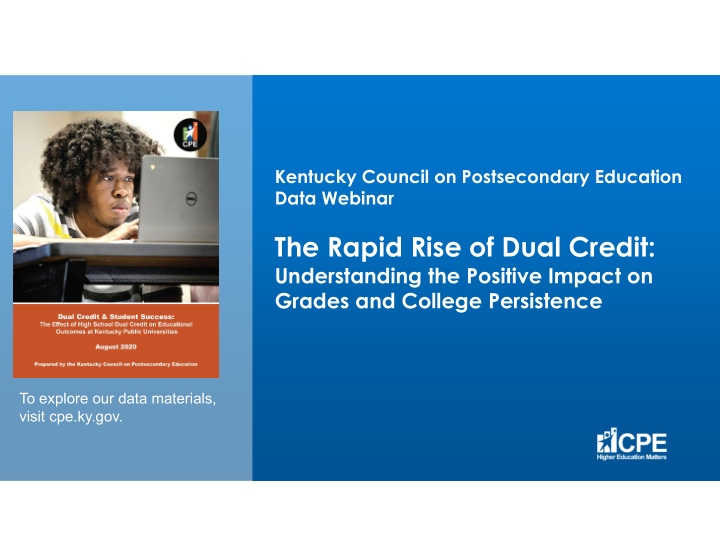



Kentucky Council on Postsecondary Education Data Webinar The Rapid Rise of Dual Credit: Understanding the Positive Impact on Grades and College Persistence To explore our data materials, visit cpe.ky.gov.
Today’s focus: Student outcomes at Kentucky public 4-year universities. Upcoming CPE studies: • Two-year community and technical colleges • All high school graduates, assessing postsecondary outcomes based on coursework pathways during high school years. To explore our data materials, visit cpe.ky.gov.
Our panelists – Amanda Ellis , CPE Associate Vice President for P-20 Policy and Programs – Lexy Riddle , Murray State University Student and Dual Credit Participant – John Darnell , Bellevue Middle/High School Principal – Brittney Sholar , WKU Interim Dual Credit Program Manager 3
Overall growth of dual credit enrollment Kentucky Public Four-Year, AIKCU and KCTCS Institutions 2014-15 2015-16 2016-17 2017-18 2018-19 2019-20 45,000 40,000 40,821 35,000 36,933 34,764 30,000 30,067 25,000 23,954 20,000 23,307 15,000 10,000 5,000 0 4
Dual credit participant characteristics • More likely to be female and white or Asian. • Less likely to be part of an underrepresented minority (URM) group. • Slightly more likely to be from low-income families (but less likely if both low-income and minority). • Starting in 2016, the percentage of Kentucky college students with dual credit is higher than the percentage without, possibly due to CPE’s dual credit policy and Kentucky’s dual credit scholarships. 5
Dual credit participants were more likely to persist to a second year of college. Probability of Persistence Non-Participant Participant 92.5% 92.2% Strongest Effect 92.0% • Low-Income/White or Asian 91.5% • Low-Income/URM 91.0% No Effect 90.5% 90.0% • Underprepared 90.1% 89.5% 89.0% 6
Dual credit participants were more likely to obtain a first-year GPA of 3.0 or higher Probability of Persistence Strongest Effect Non-Participant Participant • Low-Income/White or Asian 62.0% 60.0% • Low-Income/URM 60.0% 58.0% • Male 56.0% • C and B grade level students 54.0% *outcome variable continuous first-year GPA No Effect 52.0% 50.0% • Underprepared 50.8% 48.0% • Not Low-Income/URM 46.0% 7
Questions? Contact Our Research Staff David Mahan Associate Vice President, Data & Analytics Jie ‘Grace’ Dai Senior Associate, Data & Analytics Melissa Young Executive Director of Special Projects Travis Muncie Director, Data & Analytics Twitter: CPENews and CPEPres Website: http://cpe.ky.gov Facebook: KYCPE
Recommend
More recommend